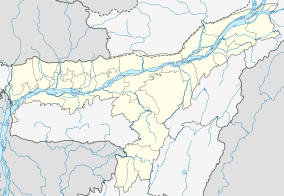National park in Assam, India
| Nameri National Park & Tiger Reserve | |
|---|---|
| IUCN category II (national park) | |
 | |
 | |
| Location | Sonitpur Assam India |
| Nearest city | Tezpur, India |
| Coordinates | 27°0′36″N 92°47′24″E / 27.01000°N 92.79000°E / 27.01000; 92.79000 |
| Area | 200 km (77.2 sq mi) |
| Established | 1978 |
| Governing body | Ministry of Environment and Forests, Government of India |
| Website | http://nameritr.org |
Nameri National Park is a national park in the foothills of the eastern Himalayas in the Sonitpur District of Assam, India, about 35 km from Tezpur. Nameri is about 9 km from Chariduar, the nearest village.
Nameri shares its northern boundary with the Pakhui Wildlife Sanctuary of Arunachal Pradesh. Together they constitute an area of over 1,000 km (390 sq mi), of which Nameri has a total area of 200 km (77 sq mi). Nameri National Park was declared as Tiger Reserve in the year 2000, and is the second Tiger reserve of Assam after Manas Tiger Reserve. It has two core areas: Nameri National Park and Sonai- Rupai Wildlife (Satellite Core of the Nameri Tiger Reserve). The river Jia-Bharali is the lifeline of Nameri, which flows along the southern boundary of the park from northwest to southeast. In the east, the river Bor-Dikorai is a tributary of river Jia-Bharali, flowing along the southern boundary from northeast to southwest.
Rivers

The Kameng River of Assam was famous since the time of British for the golden mahseer angling. The angling was officially banned in 2011. The main Rivers are Jia- Bhoroli and Bor Dikorai. Other tributaries of these two rivers are: Diji, Dinai, Nameri, Khari, Upper Dikiri which originates in the Arunachal Himalayas and flows through Pakke TR and Nameri TR.
History
The park was declared a reserve forest on 17 October 1978. It was set up as a Nameri Sanctuary on 18 September 1985 with an area of 137 km (85 mi) as a part of Naduar Forest Reserve. Until then the Nameri National Park was heavily used for logging. Another 75 km (47 mi) was added on 15 November 1998 when it was officially established as a National Park.
Flora

Nameri National Park harbours over 600 floral species. Some notable species are Gmelina arborea, Michelia champaca, Amoora wallichi, Chukrasia tabularis, Ajar, Urium poma, Bhelu, Agaru, Rudraksha, Bonjolokia, Hatipolia akhakan, Hollock, Nahor. It is home for orchids like Dendrobium, Cymbidium and Cypripedioideae.
Fauna


Nameri National Park provides habitat for Bengal tiger, Indian leopard, clouded leopard, marbled cat, leopard cat, hog deer, sambar, dhole, gaur, barking deer, wild boar, sloth bear, Himalayan black bear, capped langur and Indian giant squirrel. The white winged wood duck, great pied hornbill, wreathed hornbill, rufous necked hornbill, black stork, ibisbill, blue-bearded bee-eaters, babblers, plovers and many other birds are also present.

In 2005, 374 bird species were recorded in Nameri National Park.
Conflicts and threats
Nameri faces two threats: One is due to continued official logging in the area of Sonitpur. The other major threat for Nameri is human/animal conflict due to around 3000 cattle grazing the forest. There is another human/animal conflict due to the vast group of elephants in Nameri. The human-elephant conflict arose mainly due to herds of elephants raiding crops, damaging homes, and killing cattle. In a study published in November 2011, researchers found correlation between the human-elephant conflict and forest cover dropping below 30-40%. There are several cases of elephant deaths. In 2001 there were 18 elephant deaths.
References
- Tourism.webindia123.com
- "An ornithological survey in north-east India". Archived from the original on 31 January 2014. Retrieved 27 June 2011.
{{cite web}}: CS1 maint: bot: original URL status unknown (link) - ^ "Press Information Bureau English Releases". Retrieved 8 July 2011.
- "Nameri National Park » Naparks". 23 August 2023. Retrieved 27 August 2023.
- ^ "Nameri-Aassam". Archived from the original on 25 September 2011. Retrieved 7 July 2011.
- Barua, M.; Sharma, P. "The birds of Nameri National Park, Assam, India". Forktail. S2CID 126539346.
- ^ Chartier, Laura; Zimmermann, Alexandra; Ladle, Richard J. (2011). "Habitat loss and human–elephant conflict in Assam, India: does a critical threshold exist?". Oryx. 45 (4): 528–533. doi:10.1017/S0030605311000044. ISSN 1365-3008. S2CID 86804369.
- "PROTECTED AREA UPDATE". Archived from the original on 1 October 2011. Retrieved 8 July 2011.
External links
 Nameri National Park travel guide from Wikivoyage
Nameri National Park travel guide from Wikivoyage
